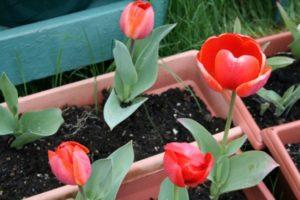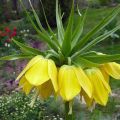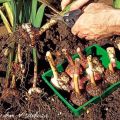How and where is it better to store tulip bulbs, rules and choice of place
Motley placers of tulips on flower beds are a sure sign of the coming of spring. Spectacular flashes of bright colors will not leave anyone indifferent. No wonder in the distant past, these plants were worth a fortune. Years passed. Exotic guests became available to all comers and rightfully took pride of place in flower beds. In order to grow this miracle in your garden, you need to know how to store precious tulip bulbs.
Reasons for digging tulips
In order to grow beautiful flowers, you must adhere to the basic rules of agricultural technology. One of the main requirements is the annual digging of the bulbs. The procedure allows for guaranteed preservation of the varietal qualities of the plants and obtaining large bulbs for autumn planting. Plus, regular digging helps to avoid rot and disease. An exception is made only for children - miniature bulbs. They need to get stronger and grow up.
The nodules are buried in the garden bed and left alone for 2 years. By regularly removing the corms, you can safely do the redevelopment of the flower garden, without fear of damaging the plants. After flowering, the corms left in the soil are deepened into the ground. This maneuver enables tulips to survive the winter cold. In the spring, the plant will begin to strive for light, and the bright, handsome man will continue its life cycle. But every year the bulb goes into the ground more and more. Making its way through the thickness of the earth, the plant spends a lot of energy instead of accumulating it.
As a result, the flowers become smaller, tulips become frail and unsightly. Often, several daughter bulbs grow in such abandoned nests. They are sorely lacking space and nutrition, so tulips grow ugly.
Ways to preserve bulbs until spring
Tulips are planted about a month before the first frost. If for some reason this could not be done, it is better to postpone the event until spring. There are several ways to store planting material.

Dry storage
If there are few corms, you can use the dry storage method. In order for the seed to be preserved without damage, each bulb is wrapped in paper. Then the packed copies are placed in a common paper bag and put into the refrigerator. The best storage space is the vegetable drawer. This is usually the bottom of the refrigerator. Owners of private houses can be advised as a storage basement.In this case, the planting material is placed in a wooden box filled with sand or sawdust.
The dry method is convenient and simple, but tulips after such a hibernation will bloom a little later than usual.
Wet germination
If you want to wait for the Dutch beauties to bloom at the right time, you can use the wet germination method. To do this, you need to prepare a perforated plastic container. Disinfect and fill the container with sawdust or peat.
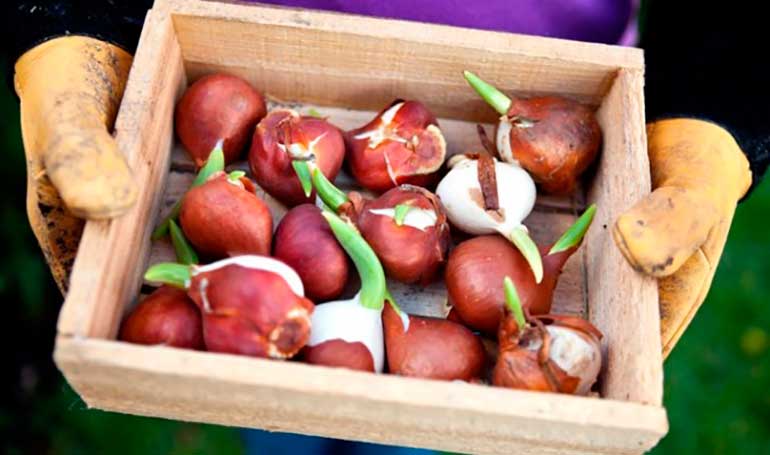
Put the onions on the prepared substrate, placing them with the bottom down. Then the nodules must be sprinkled with peat or sawdust and removed to the cellar before germination. In the spring, tulips that have hatched should be planted in a flower bed.
Early distillation
By subjecting the bulbs to various procedures, you can get blooming tulips for any holiday. By changing the temperature regime during storage, you can slow down or bring the flowering period closer. A fragrant bright composition will decorate the festive table on March 8 or transform the house into a Christmas night.
If you want to get flowers by March 8, you need to prepare in advance for forcing tulips. For this, the best specimens are chosen in the spring. Plants are looked after, fed individually. This is necessary in order for the bulbs to accumulate more nutrients.
3-4 days after the opening of the buds, the flower heads of the selected tulips are cut off. After digging, the specimens intended for distillation are dried and stored separately. During storage, the air temperature is gradually reduced. If in August the optimal temperature regime is 20 degrees, then in October the corms are stored at 16 degrees.

From November, planting material for germination must be kept in the refrigerator. The planting capacity and substrate are prepared in advance. The pot or drawer must have drainage holes. You can make the substrate yourself or purchase it at a flower shop. The composition of the soil mixture should consist of 3 components in equal parts:
- garden land;
- river sand;
- humus.
The bulbs are removed from the refrigerator and carefully examined. Having chosen healthy specimens, they are soaked in a weak solution of potassium permanganate for 30 minutes. The soil is disinfected with the same solution and the container is filled with a substrate. In order to avoid the process of rotting tubers, Glyocladin tablets are added to the ground. The treated corms are lightly pressed into the loose soil. Tulips are planted quite tightly, at a distance of 1-2 cm from each other. The planted material is sprinkled with a substrate and moistened, leaving only the tips of the bulbs on top.
The future composition is removed to the refrigerator, where it will be stored until the desired moment. They take out the box a month before the plants should bloom. The sprouts that have appeared must be highlighted using a phytolamp. After the end of flowering, tulips are cut, but they continue to water, because their life is not over yet. After a month, the bulbs are removed from the ground, dried and stored until autumn.

Forcing for Christmas is done a little differently. By the winter holiday, the corms should already have fully formed all parts of the future flower. For a Christmas composition, the bulb is dug out ahead of schedule, and then kept at a temperature of 32-34 degrees for a week. The shock procedure will speed up important processes. Further actions will be the same as in the previous case. For forcing, Dutch bulbs labeled "Gigant" are best suited.
When should the bulbs be removed?
The changes taking place with tulips themselves will tell you when to dig out the faded beauties. Signs of readiness to dig:
- Most of the leaves turn yellow (about ⅓).
- The scales of the bulbs turn brown.
- The flower stem has become flexible. They can wrap your finger in a circle.
If the corms are removed ahead of time, the plant will not have time to stock up on nutrients. This has a detrimental effect on the decorative qualities and the general condition of the flower. In addition, fewer replacement bulbs will form in the underground part of the plant, and their quality will be poor.
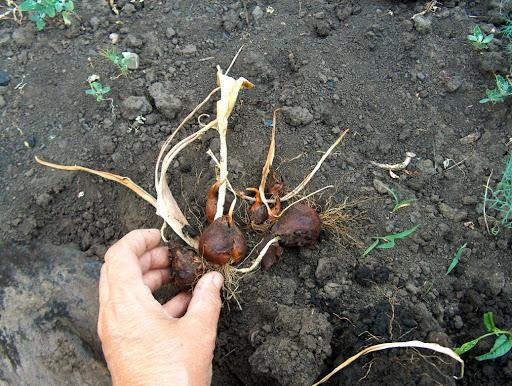
Late digging is also undesirable. Delayed action increases the risk of tulips being affected by infectious diseases. Horizontal breaks appear on the replacement bulbs. This significantly impairs the presentation of the planting material. With late digging, it is difficult to extract the tubers without loss. Nests of replacement bulbs disintegrate, and a good part of future tulips remains in the ground. The procedure is carried out in dry but not hot weather.
After digging, the planting material is inspected, sorted into groups by size and grade, and then laid to dry. Sick and severely damaged specimens are removed. Plants are processed for 4 weeks at a temperature of 23-25 degrees. Then the bulbs are stored in order to be planted again in the fall.
What should be the storage space?
Professional flower growers use such a miracle of technology as a heat chamber. The equipment is expensive, for a simple flower lover it is not at all necessary to purchase this.
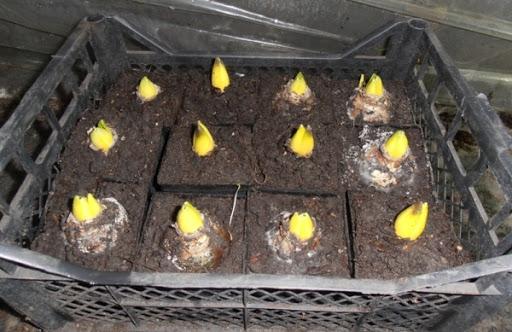
Any well-ventilated, dark room can be used to store planting material. The store should be protected from direct sunlight. It should not be hot, 30-degree heat can lead to dehydration and death of the bulbs. The optimum storage temperature for tubers is 20 degrees. For this purpose, an attic, terrace or veranda of a country house is quite suitable. You can store bulbs in a dry basement or cellar. The tubers will feel quite comfortable in the conditions of a city apartment, if you allocate a suitable room for this purpose.
The bulbs are placed in a box in one layer. It is recommended to cover the seed with sawdust. They will help keep the tubers dry.
Container preparation
A wooden box is ideal for storing planting material. Experienced flower growers recommend making a hole in the container and placing a thermometer there. This will help control the temperature of the bulbs.
It is not necessary to resort to such tricks. For storage, fruit crates, wicker baskets or fabric bags are perfect. It is recommended to disinfect the selected container before use. Don't use cardboard boxes. They can easily get wet.

Basic storage rules before planting
The beauty of the future flower garden depends on the quality of the seed.
- The bulbs must be dry and clean. The material is dried at a temperature of 23-25 degrees.
- The humidity level should be 70-80%
- Choose a well-ventilated, dark area.
- The air temperature should be 20 degrees. In September, lower it a little - to 17 degrees.
- Before laying for storage, corms are processed in a weak solution of potassium permanganate.
Potential problems and solutions
High humidity and improper storage temperatures can lead to rotting of the bulbs and mold. Damaged specimens are treated with Fundazole or a solution of potassium permanganate. All material is sorted out, healthy specimens are separated and stored separately. Severely affected tubers are discarded.
If the onions are slightly damaged, the affected areas are cut off, and the wounds are treated with brilliant green. Rodents often precipitate planting material. In this case, the corms are placed in a stocking or mesh and suspended from the ceiling.
Processing after storage
Before planting, the corms are soaked in a solution of potassium permanganate. This will protect the material from the invasion of pests and diseases.In addition, the procedure will help satisfy the manganese requirement of tulips.

